Spiegelworld speaks to Ceramicist Daniel Shapiro of THE HOOK, the brand new Spiegelworld venue, opening at Caesars Atlantic City in June 2023.

Hi Daniel, what are you developing and creating for The Hook?
So, I’m a ceramic artist in St Louis who makes sculptural light fittings and furniture, and for The Hook I’m creating 27 individually hand-crafted lighting sconces that will be used to decorate the theater, and then there are three flush mount lights and one big chandelier. They have the same style and follow a story and characters. There’s also a table lamp for the bar that we still need to get started on.
Big? How big is the chandelier?
It’s 35″ by 28″ by 12″ inches tall. It’s all ceramic with a sprayed-on glaze coating. It requires two fires; the bisque fire then the glaze fire. Essentially I melt glass over clay.
Tell us a little bit about yourself. When did you start creating art?
It hasn’t been that long. It was 2017 when I took my first neighborhood studio pottery class. My wife and I did the class together because we needed something to do on a Saturday, and I really took to it because of its immediate creation. I’ve worked in advertising for the last 15 years, and it’s a very committee-driven process. I like the result and that way of making a living being a creative person. Still, something gets lost as an artist when you have to consider so many other people’s opinions and be collaborative. You start to lose your voice, especially when doing things for brands. So you know, it’s commerce. It’s not pure art.
When I took that class, I got obsessed and took it really far. I was working in the community studio, and my pieces just started to grow so they wouldn’t fit on shelves, and sharing studio time with other students was an issue. That’s when I moved to St. Louis and started my own studio. Here I have the space to grow and take ceramics to the next level. Then the pandemic hit, and I was working from home and sometimes not working, so I decided to take it as an opportunity to invest in myself to develop my skill to achieve a style and look.
What materials do you utilize?
Everything I’m building is stoneware. It’s clay with glaze plus all the standard lighting components. All the pieces include an extruder that creates the tubes, and everything else is hand thrown on the wheel and then hand-built into one piece.
What drew you to lighting?
I get that question a lot, and I’ve thought about it a lot. My theory on why I’m drawn to lighting is that I’ve worked in advertising for so long. As you probably know, advertising is about subverting the expectation of people by working through a medium. Your job as a creative person is to subvert that medium and create a surprise. Lighting is that base where everybody thinks they know what a lamp looks like, which poses an opportunity to make something different that can say something through an object that people don’t expect.
That’s probably why, but also I really wanted lamps in my house, and that’s how it started. I was working in the studio and thought, I have a bunch of bowls, plates, and cups, and now I want to personalize my space. Once you start building things for yourself, other people see it, and they want it. Then it evolves.
What is your typical inspiration when you’re making a piece?
This body of work in the past few years has a similar inspiration to me; it feels like a collection. Some pieces are just straightforward designs; this will be a sconce, and I won’t try to say anything with this. I’m at the crossroads of being a designer and an artist.
Other pieces, which most of the work I’m doing for Spiegelworld are, tilt more toward the artist in me and are about the entanglement of our paths as people. Especially the chandelier and the flash mounts, where there are multiple lights, and they all end up in the same place, but they’re tingling around each other. When building it, I imagine each light to be its own beam, and the tubes represent its path. Imagine the relationship between them. Some are total loners and don’t fit into the group for whatever reason. Some of them are like two people that are in love, and others are two people that are falling out of love. When I imagine those characters on them, it influences how I shape each of them and their expressions. I like the idea that you can look up, and there’s a whole story above you.
Do you start with a storyline and then start your design process?
Because it’s a mix of design and art, a lot of the work starts in a utilitarian way. I know a story will play into it later, but a lot of it starts with; we need a flush mount, and there needs to be a center with a cap that hooks up to a junction box. From there, you start to imagine the objects and shapes and think about what you have to build for the piece to be useful and how that can play into the story.
I see a lot of parallels between my career and advertising because every advertising piece starts with a brief of what this is supposed to achieve, what product it’s supposed to push, and a
list of pretty dry things. In the best-case scenario, in the end, you come out with something creative and fun. That’s how I see the process with this as well; one side of my brain enjoys solving problems and not just making something creative.
It takes a special person to figure that out because you will inevitably run into things you’re not naturally gifted at. Some people are incredibly creative, and then they have to figure out the framework, tools, and technical skills required. It’s a cool chance to grow and expand on something you may not be comfortable with.

